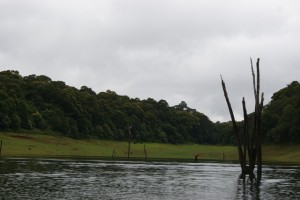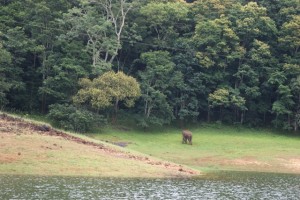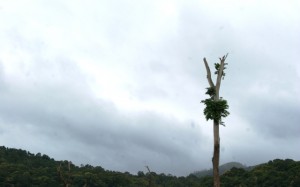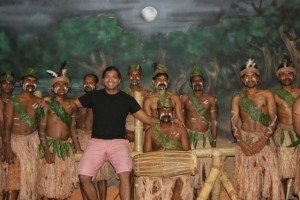
“Oh, hey, look over there, a bison.” A stocky Englishman said with field glasses glued over his face. Telescope lenses loomed like missile launchers in the general direction, followed with muffled ‘ooh’ and ‘aah’ from behind viewfinders.
“Hey, a bison.” A dozen others repeated like litany.
The tracker was now over the faux pas and joined the chorus with a corrected, ‘Look, there bison’ chirp. The happy chap had earned his tip.
Excitement from spotting wildlife did not always come with such happy endings. Only three years ago a sightseeing boat capsized drowning 45 tourists. The boat whose maximum capacity was 74 was carrying 87 tourists across the deep lake right in centre of the wildlife sanctuary for sightseeing at the time of the mishap. Apparently the driver had shouted out a sighting of a herd of wild bison which emerged from the thick forest surrounding the water body and all the tourists had rushed to one side of the boat toppling it. Lessons were learnt, as was evident: there were less than 50 passengers in our boat, bright orange lifebuoys were plonked down our necks as soon as everyone was seated and standing up was discouraged with a firm hand on the shoulder.
We had reached Thekkady that afternoon from Kochi – a winding, lush green drive of almost 200 kilometres. En route we had stopped by a toddy shop; a friend had advised that the best time to savour the purest toddy was early mornings. It was when the tappers had just disentangled from the coconut and palm trees and the toddy was still fomenting fresh in the gourd-like containers latched to their loins with coir; toddy shop owners would be yet to transfer its contents into the barrels which either contained leftover toddy or could be doused with liberal doses of several ‘mixes’ to make it extra potent. These ‘mixes’ would be variably salvaged chemicals from extinct batteries or simply arrack – depending on whom you asked and where. Sometime back I even got ‘centipedes’ as a possible potency enhancer from a toddy shop near a touristy beach. From a roadside co-drinker in Andhra Pradesh, I got a simple ‘acid’ for answer. He was too gone to tell me which acid, specifically. Or maybe he did tell me.

“We export our tea to all parts of the world,” he offered. “It is processed in our own factories personally supervised by me.” He waited a moment for probably some kind of appreciation. I smiled at him for the tea – a Twinings Classic but with more body and flavour – and he launched on a long discourse which, if I had taken notes, would have probably made me an informed speaker at world tea conferences.
The Periyar Wildlife Sanctuary or simply ‘Thekkady’ is a 777 sq km tiger reserve, the most popular wildlife sanctuary in south India. Though billed as a ‘tiger reserve’ spotting a tiger here is a rarity. Some 10 years ago while a student at the Kerala University campus I with a friend applied for the public participation in a tiger census survey advertised by the forest department. We were selected. The training included how to count the tigers from their pugmarks – we would pour freshly mixed plaster of Paris into the depression on the ground which would solidify after a few minutes. We were also trained to watch the tail of the tiger in the eventuality of coming face-to-face with one; a small twitch would mean that it was measuring the distance it had to leap to make you a meal. We had to shift positions soon after this twitch happened and the tiger would land where you stood. As simple as that. For an elephant, just run around in circles. Equally simple. But the biggest fear was the now-executed forest brigand Veerappan who was taking hostages almost as a hobby during those days; our training didn’t include what to do when kidnapped.
“That’s why we are sending two armed guards with you,” pointed out a forest officer. The armed guards’ guns were rusted and antique and later on they confessed that their only training was to shoot in the air to scatter an agitated lot of wild jumbos. Nevertheless, we completed the survey in the interior-most part of the reservoir where no tourist or public has access to otherwise. Even during the one week there, we didn’t see any tiger but collected 15 pugmarks from six different tigers. So sum up the chances of spotting big game when you are in a wide, canopied boat, chugging across the water, lit up with flashes and casting a thousand shouts of wonder.

Just as we were about to give up on our attempts to spot game, a crew member whose job was to keep an eye on shifty passengers announced with as much interest as he could muster, ‘Wild elephant.’ A forlorn looking elephant was on the other side of the bank making its way towards the water. But probably seeing the boat it stopped short and instead made a beeline back to the trees. Halfway it paused as if it suddenly remembered something and came back, this time tracing a path parallel to the shore. It was still indecisively gambolling about a few metres away from the water on our way back – a full hour later. Probably it was waiting for the prying cameras to clear off before taking a skinny dip.

We were staying at the Aranya Nivas belonging to the Kerala State Tourism Development Corporation, a refurbished building from the colonial era. Sunny, who had been working here since the property opened doors over three decades ago, told us about the days when it was dangerous to venture out after 5 p.m. While the tuskers roamed freely, there were also the occasional leopard and fox which came out for the gaur and sambar out to quench thirst. Today you get to spot a Nilgiri Langur from your open window and the lion-tailed macaque if you are lucky. And awake.





2 Comments
Puru
I have heard a lot about Thekkady, will plan a trip next year. Nice informative post 🙂
wanderadmin
Thank you Puru… Yep, Thekkady is a must-do in Kerala!